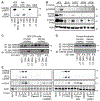Human DNA-PK activates a STING-independent DNA sensing pathway
- PMID: 31980485
- PMCID: PMC7081723
- DOI: 10.1126/sciimmunol.aba4219
Human DNA-PK activates a STING-independent DNA sensing pathway
Abstract
Detection of intracellular DNA by the cGAS-STING pathway activates a type I interferon-mediated innate immune response that protects from virus infection. Whether there are additional DNA sensing pathways, and how such pathways might function, remains controversial. We show here that humans-but not laboratory mice-have a second, potent, STING-independent DNA sensing pathway (SIDSP). We identify human DNA-dependent protein kinase (DNA-PK) as the sensor of this pathway and demonstrate that DNA-PK activity drives a robust and broad antiviral response. We show that the E1A oncoprotein of human adenovirus 5 and the ICP0 protein of herpes simplex virus 1 block this response. We found heat shock protein HSPA8/HSC70 as a target for inducible phosphorylation in the DNA-PK antiviral pathway. Last, we demonstrate that DNA damage and detection of foreign DNA trigger distinct modalities of DNA-PK activity. These findings reveal the existence, sensor, a specific downstream target, and viral antagonists of a SIDSP in human cells.
Copyright © 2020 The Authors, some rights reserved; exclusive licensee American Association for the Advancement of Science. No claim to original U.S. Government Works.
Conflict of interest statement
Conflict of Interests
A patent application describing the modulation of DNA-PK for treating human diseases is currently pending.
Figures







Comment in
-
An Antiviral DNA Response without the STING?Trends Immunol. 2020 May;41(5):362-364. doi: 10.1016/j.it.2020.03.010. Epub 2020 Apr 15. Trends Immunol. 2020. PMID: 32305305
References
Publication types
MeSH terms
Substances
Grants and funding
LinkOut - more resources
Full Text Sources
Other Literature Sources
Molecular Biology Databases
Research Materials
Miscellaneous

